File Info
| Exam | Oracle Datbase 12c SQL |
| Number | 1z0-071 |
| File Name | Oracle.1z0-071.PracticeTest.2019-06-19.131q.vcex |
| Size | 13 MB |
| Posted | Jun 19, 2019 |
| Download | Oracle.1z0-071.PracticeTest.2019-06-19.131q.vcex |
How to open VCEX & EXAM Files?
Files with VCEX & EXAM extensions can be opened by ProfExam Simulator.
Coupon: MASTEREXAM
With discount: 20%





Demo Questions
Question 1
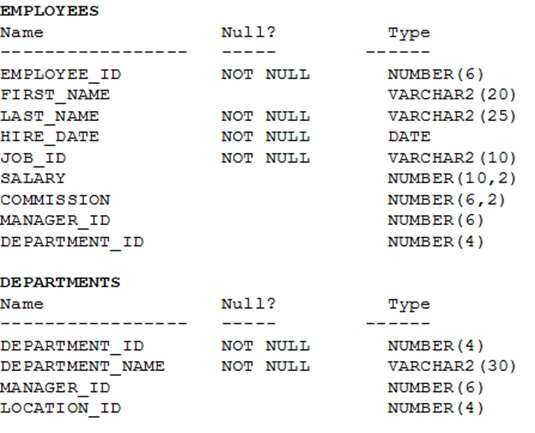
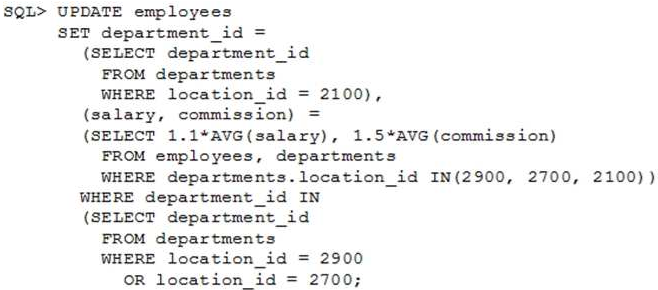
View the exhibit and examine the structures of the EMPLOYEES and DEPARTMENTS tables.

You want to update EMPLOYEES table as follows:
- Update only those employees who work in Boston or Seattle (locations 2900 and 2700).
- Set department_id for these employees to the department_id corresponding to London (location_id 2100).
- Set the employees' salary in location_id 2100 to 1.1 times the average salary of their department.
- Set the employees' commission in location_id 2100 to 1.5 times the average commission of their department.
You issue the following command:

What is outcome?
- It generates an error because multiple columns (SALARY, COMMISSION) cannot be specified together in an UPDATE statement.
- It generates an error because a subquery cannot have a join condition in a UPDATE statement.
- It executes successfully and gives the desired update
- It executes successfully but does not give the desired update
Correct answer: D
Explanation:
Question 2

Evaluate the following two queries:

Which statement is true regarding the above two queries?
- Performance would improve in query 2 only if there are null values in the CUST_CREDIT_LIMIT column.
- There would be no change in performance.
- Performance would degrade in query 2.
- Performance would improve in query 2.
Correct answer: B
Question 3
Examine the business rule:
Each student can work on multiple projects and each project can have multiple students.
You need to design an Entity Relationship Model (ERD) for optimal data storage and allow for generating reports in this format:
STUDENT_ID FIRST_NAME LAST_NAME PROJECT_ID PROJECT_NAME PROJECT_TASK
Which two statements are true in this scenario? (Choose two.)
- The ERD must have a 1:M relationship between the STUDENTS and PROJECTS entities.
- The ERD must have a M:M relationship between the STUDENTS and PROJECTS entities that must be resolved into 1:M relationships.
- STUDENT_ID must be the primary key in the STUDENTS entity and foreign key in the PROJECTS entity.
- PROJECT_ID must be the primary key in the PROJECTS entity and foreign key in the STUDENTS entity.
- An associative table must be created with a composite key of STUDENT_ID and PROJECT_ID, which is the foreign key linked to the STUDENTS and PROJECTS entities.
Correct answer: BE
Explanation:
References:http://www.oracle.com/technetwork/issue-archive/2011/11-nov/o61sql-512018.html References:
http://www.oracle.com/technetwork/issue-archive/2011/11-nov/o61sql-512018.html
Question 4
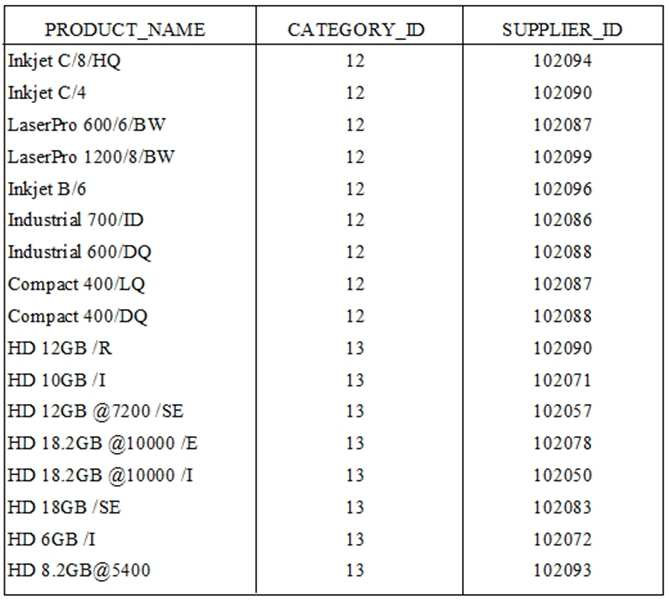
View the Exhibit and examine the details of PRODUCT_INFORMATION table.

You have the requirement to display PRODUCT_NAME from the table where the CATEGORY_ID column has values 12 or 13, and the SUPPLIER_ID column has the value 102088. You executed the following SQL statement:
SELECT product_name
FROM product_information
WHERE (category_id = 12 AND category_id = 13) AND supplier_id = 102088;
Which statement is true regarding the execution of the query?
- It would not execute because the same column has been used in both sides of the AND logical operator to form the condition.
- It would not execute because the entire WHERE clause condition is not enclosed within the parentheses.
- It would execute and the output would display the desired result.
- It would execute but the output would return no rows.
Correct answer: D
Question 5
Which two statements are true regarding the EXISTS operator used in the correlated subqueries? (Choose two.)
- The outer query stops evaluating the result set of the inner query when the first value is found.
- It is used to test whether the values retrieved by the inner query exist in the result of the outer query.
- It is used to test whether the values retrieved by the outer query exist in the result set of the inner query.
- The outer query continues evaluating the result set of the inner query until all the values in the result set are processed.
Correct answer: AC
Explanation:
References:http://www.techonthenet.com/oracle/exists.php References:
http://www.techonthenet.com/oracle/exists.php
Question 6
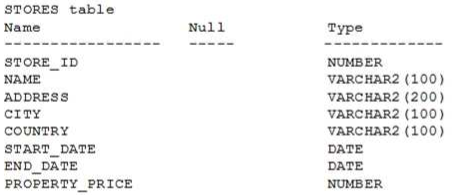
View the exhibit and examine the structure of the STORES table.

You must display the NAME of stores along with the ADDRESS, START_DATE, PROPERTY_PRICE, and the projected property price, which is 115% of property price.
The stores displayed must have START_DATE in the range of 36 months starting from 01-Jan-2000 and above.
Which SQL statement would get the desired output?
- SELECT name, concat (address| | ','| |city| |', ', country) AS full_address,start_date,property_price, property_price*115/100FROM storesWHERE MONTHS_BETWEEN (start_date, '01-JAN-2000') <=36;
- SELECT name, concat (address| | ','| |city| |', ', country) AS full_address,start_date,property_price, property_price*115/100FROM stores
- WHERE TO_NUMBER(start_date-TO_DATE('01-JAN-2000','DD-MON-RRRR')) <=36;SELECT name, address||', '||city||', '||country AS full_address, start_date,property_price, property_price*115/100FROM storesWHERE MONTHS_BETWEEN(start_date,TO_DATE('01-JAN-2000','DD-MON-RRRR')) <=36;
- SELECT name, concat (address||','| |city| |', ', country) AS full_address,start_date,property_price, property_price*115/100FROM storesWHERE MONTHS_BETWEEN (start_date, TO_DATE('01-JAN-2000','DD-MON-RRRR')) <=36;
Correct answer: D
Question 7
The BOOKS_TRANSACTIONS table exists in your database.
SQL>SELECT * FROM books_transactions ORDER BY 3;
What is the outcome on execution?
- The execution fails unless the numeral 3 in the ORDER BY clause is replaced by a column name.
- Rows are displayed in the order that they are stored in the table only for the three rows with the lowest values in the key column.
- Rows are displayed in the order that they are stored in the table only for the first three rows.
- Rows are displayed sorted in ascending order of the values in the third column in the table.
Correct answer: D
Question 8

Examine the command:

What does ON DELETE CASCADE imply?
- When the BOOKS table is dropped, the BOOK_TRANSACTIONS table is dropped.
- When the BOOKS table is dropped, all the rows in the BOOK_TRANSACTIONS table are deleted but the table structure is retained.
- When a row in the BOOKS table is deleted, the rows in the BOOK_TRANSACTIONS table whose BOOK_ID matches that of the deleted row in the BOOKS table are also deleted.
- When a value in the BOOKS.BOOK_ID column is deleted, the corresponding value is updated in the BOOKS_TRANSACTIONS.BOOK_ID column.
Correct answer: C
Question 9
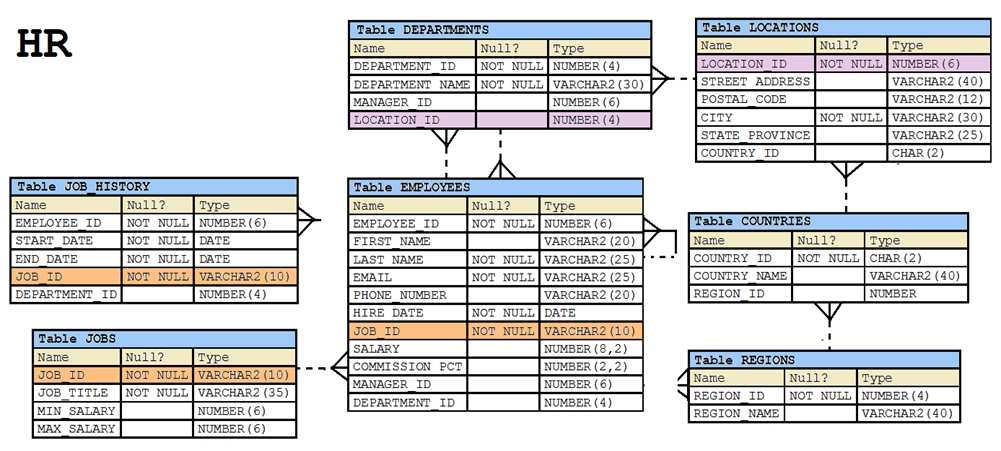
View the exhibit and examine the structure of the EMPLOYEES table.

You want to display all employees and their managers having 100 as the MANAGER_ID. You want the output in two columns: the first column would have the LAST_NAME of the managers and the second column would have LAST_NAME of the employees.
Which SQL statement would you execute?
- SELECT m.last_name "Manager", e.last_name "Employee"FROM employees m JOIN employees eON m.employee_id = e.manager_idWHERE m.manager_id = 100;
- SELECT m.last_name "Manager", e.last_name "Employee"FROM employees m JOIN employees eON m.employee_id = e.manager_idWHERE e.manager_id = 100;
- SELECT m.last_name "Manager", e.last_name "Employee"FROM employees m JOIN employees eON e.employee_id = m.manager_idWHERE m.manager_id = 100;
- SELECT m.last_name "Manager", e.last_name "Employee"FROM employees m JOIN employees eWHERE m.employee_id = e.manager_id AND e.manager_id = 100
Correct answer: B
Question 10
Which three statements are true about multiple-row subqueries?
- They can contain a subquery within a subquery.
- They can return multiple columns as well as rows.
- They cannot contain a subquery within a subquery.
- They can return only one column but multiple rows.
- They can contain group functions and GROUP BY and HAVING clauses.
- They can contain group functions and the GROUP BY clause, but not the HAVING clause.
Correct answer: ABE

